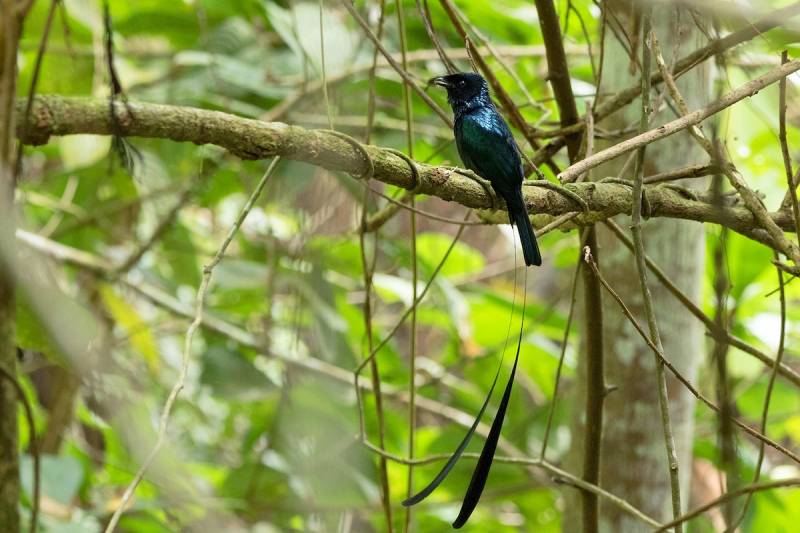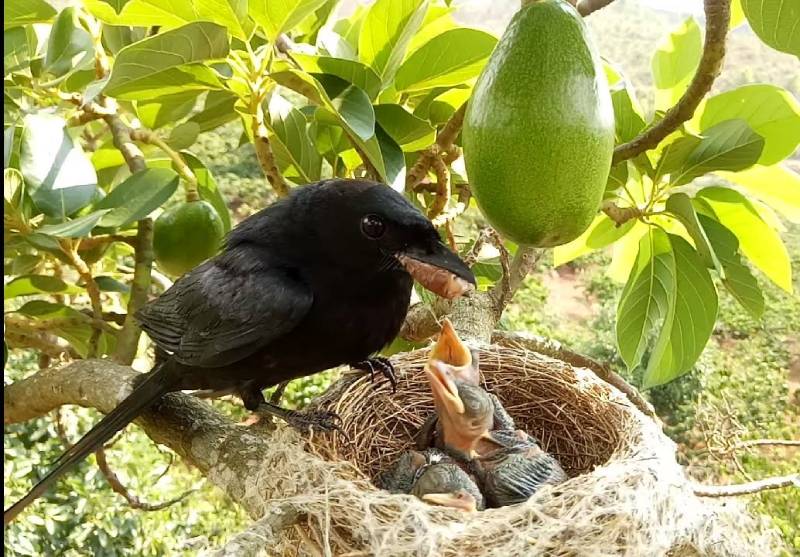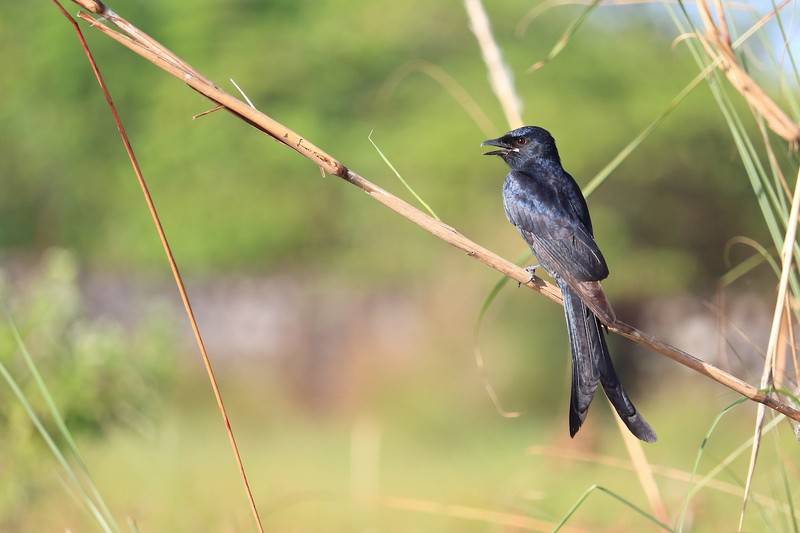The Black Drongo is a very interesting bird, with a talent for mimicking voices, so many bird players love them. If you are learning about the Black Drongo bird and intend to raise them, below will be the most basic but necessary information for you to equip yourself with in advance!
What is the Black Drongo bird?
The Black Drongo bird has the scientific name Dicrurus macrocercus, also known as Black Drongo, many sources say that they belong to the Dicruridae family. Black Drongo is one of the oldest bird species, found mainly in India, Iran, Sri and Southeast Asia. In our country, Black Drongo is present in most provinces and cities because they have migratory habits. There are currently 2 main types: Fish-tailed Black Drongo and Flag-tailed Black Drongo (long-tailed).

Characteristics and appearance of the Black Drongo bird
The Black Drongo stands out with its jet-black feathers, sharp beak, long body, on average, an adult bird can be up to 28 cm long, weighs 40-60g and often has a small white spot behind the edge of the beak. Each species will have its own characteristics and different sizes, below are some species of Black Drongo you can refer to.
Black Drongo
Scientific name is Dicrurus macrocercus, 27-29 cm long, is a resident species, common throughout the country, wintering in the South. This bird lives in open areas, agricultural land, bushes, often perching on roadsides in large numbers.
Gray black drongo
Scientific name is Dicrurus leucophaeus, 26-29 cm long, is a resident and migratory species according to altitude, relatively common throughout the country, migrating through the Northeast, wintering in the South. They live in open areas in forests, mangroves, distributed to areas with an altitude of 2,750 meters.
Dicrurus annectans
Scientific name is Dicrurus annectans, 27-32 cm long, is an uncommon migratory species in the Northeast, North and Central Central regions, uncommon migration in the Northeast, South Central regions, and the South. They live mainly in broadleaf evergreen forests, deciduous forests, mangrove forests, coastal shrubs, planted forests, secondary forests during winter and on the migration route.
Forest drow
Scientific name is Dicrurus aeneus, 22-24 cm long, is the smallest species in the family Drow, and is also a relatively common resident species throughout the country. Their habitat is evergreen broadleaf forests (green leaves all year round), semi-evergreen, deciduous forests, secondary forests, forest edges.

The flat-tailed dwarf
The scientific name is Dicrurus remifer, 25-28cm long, is a relatively common resident species throughout the country. The main habitat of this species is evergreen and semi-evergreen broadleaf forests.
The split-tailed dwarf
The scientific name is Dicrurus paradiseus, 33-36cm long, is a common resident species throughout the country. Their habitat is evergreen and semi-evergreen broadleaf forests, deciduous forests, swamp forests, secondary forests, and plantation forests.
The mane dwarf
The scientific name is Dicrurus hottentottus, 29-33cm long, is a common resident species throughout the country, migrating through the Northeast. They live in evergreen and semi-evergreen broadleaf forests, deciduous forests, secondary forests, gardens and parks during the migration season, often moving in flocks.
Habits and Reproduction of the Black Drongo
The Golden Oriole’s personality is quite aggressive, when in danger they will puff up the feathers on the top of their heads. In the wild they often live in groups, perch on tree branches, fly around to catch prey, often circling and calling loudly in the sky. Nowadays, Golden Oriole is domesticated from a young age, so when it grows up it is very obedient.
Golden Oriole is a very faithful species like white pigeons, the proof is that they only live with 1 female/male for their entire life. Golden Oriole breeds from late spring to the end of autumn, making nests by using their own saliva to bind dry grass and straw.
Each year, the female lays 2-3 clutches, each time on average giving 3-5 eggs. Golden Oriole eggs are large in color. Young birds are red-yellow, with down feathers appearing after a week. The baby Cheetah will open its eyes after about 8 days, leaving the nest on the 16th or 17th day. After 3 weeks, their tails will be relatively complete. The parents continue to feed and protect them for a month. The baby birds may stay with their parents longer, but they are often ignored to become independent early. It usually takes 2 years for the baby Cheetah to reach adulthood to be able to reproduce.

Instructions on how to raise healthy, long-lived Cheetahs
The lifespan of Cheetahs is quite low, when kept in captivity they can easily die for unknown reasons. However, if you know how and take care of them carefully, Cheetahs can live well with their owners for many years. If you are new to raising Cheetahs, here are some points you need to pay attention to:
Choosing the breed
First, the quality of the baby birds is extremely important. You should choose a Cheetah that looks healthy, smart, and has bright eyes. You can go to large bird shops because small shops are rare. Or search on groups on social networking sites to choose. Or you can make a trap for the wild Black Drongo bird using mantis bait, grasshoppers or bird chirping to attract them.
